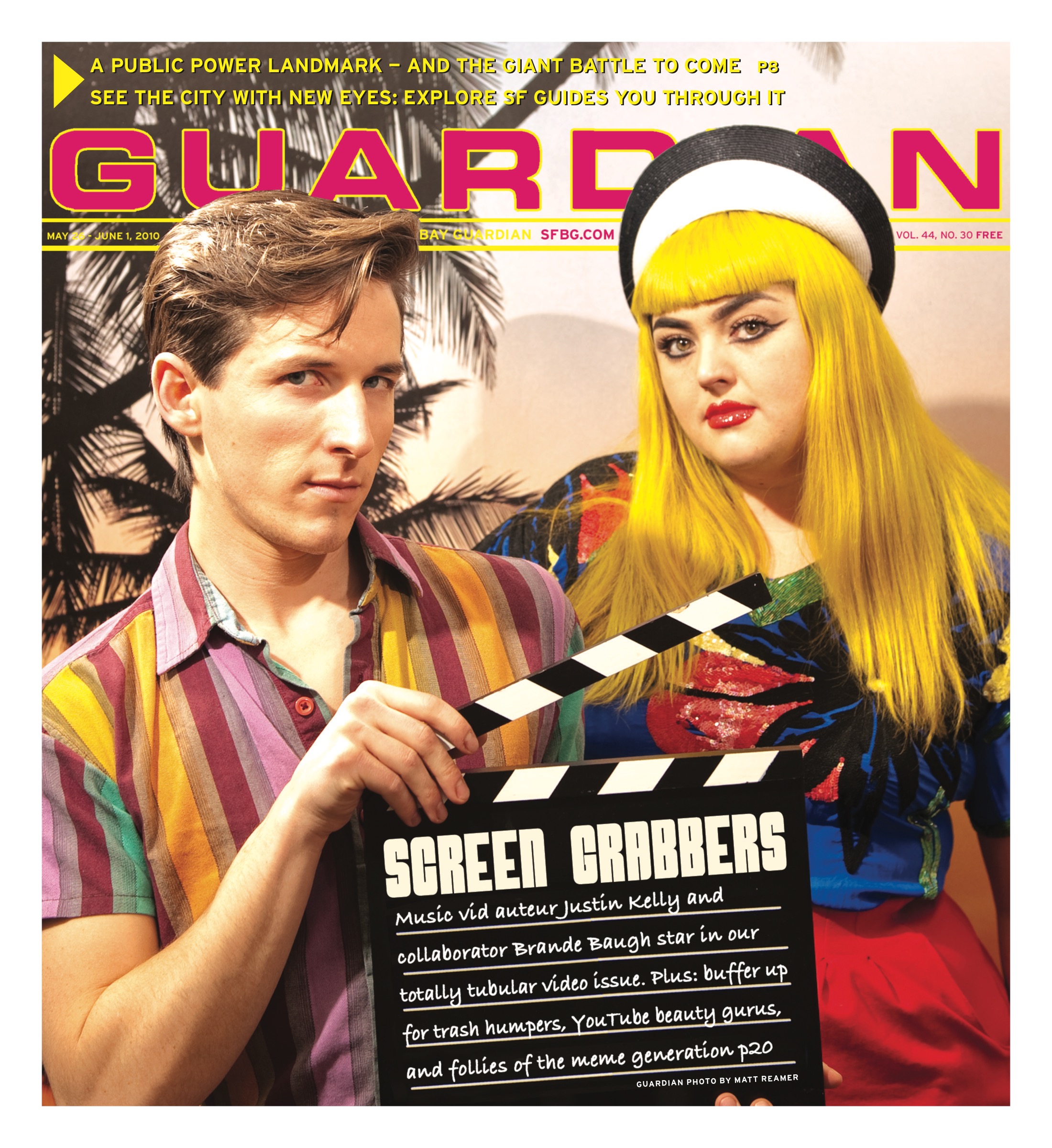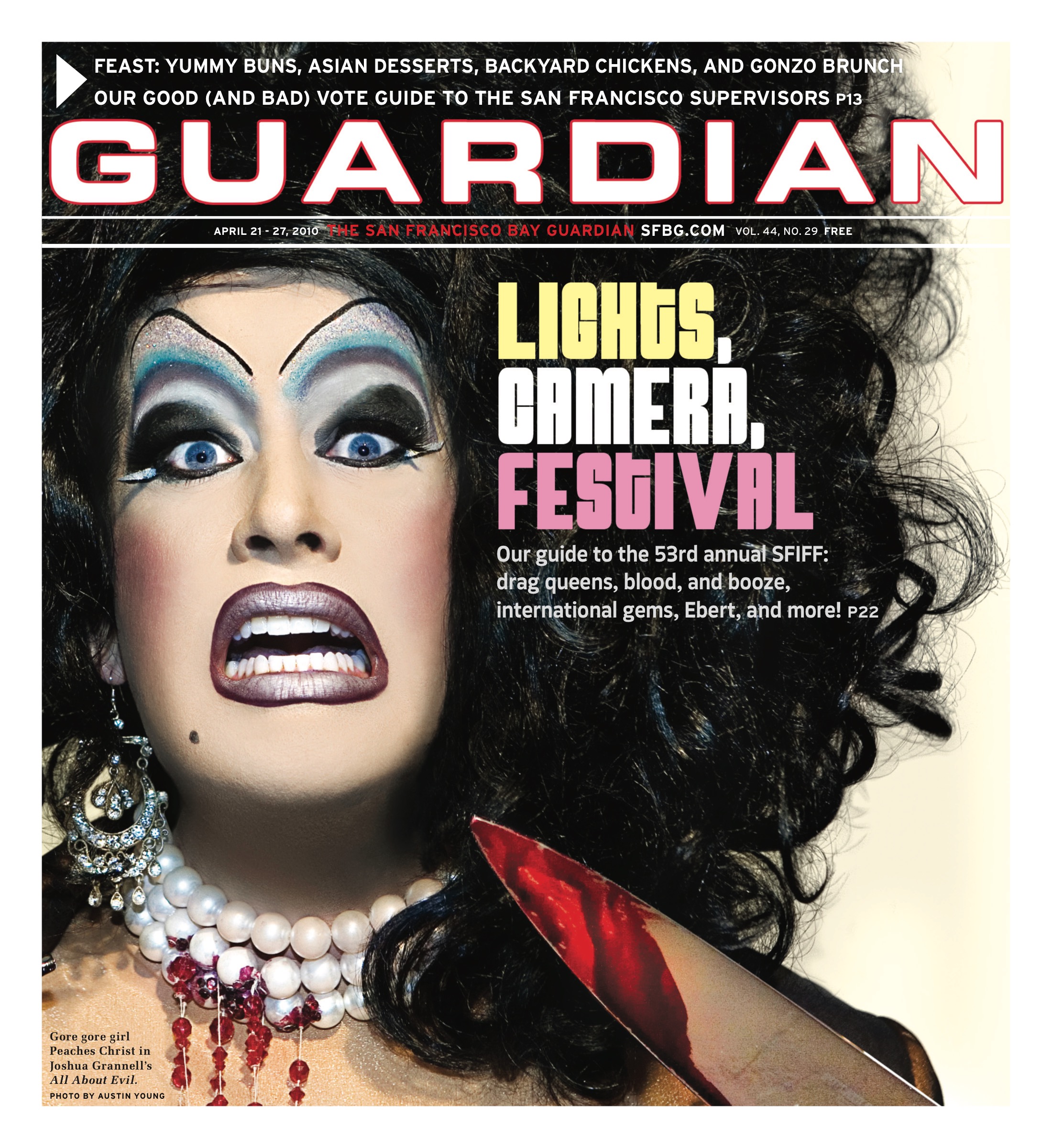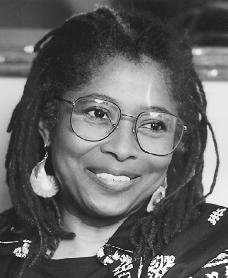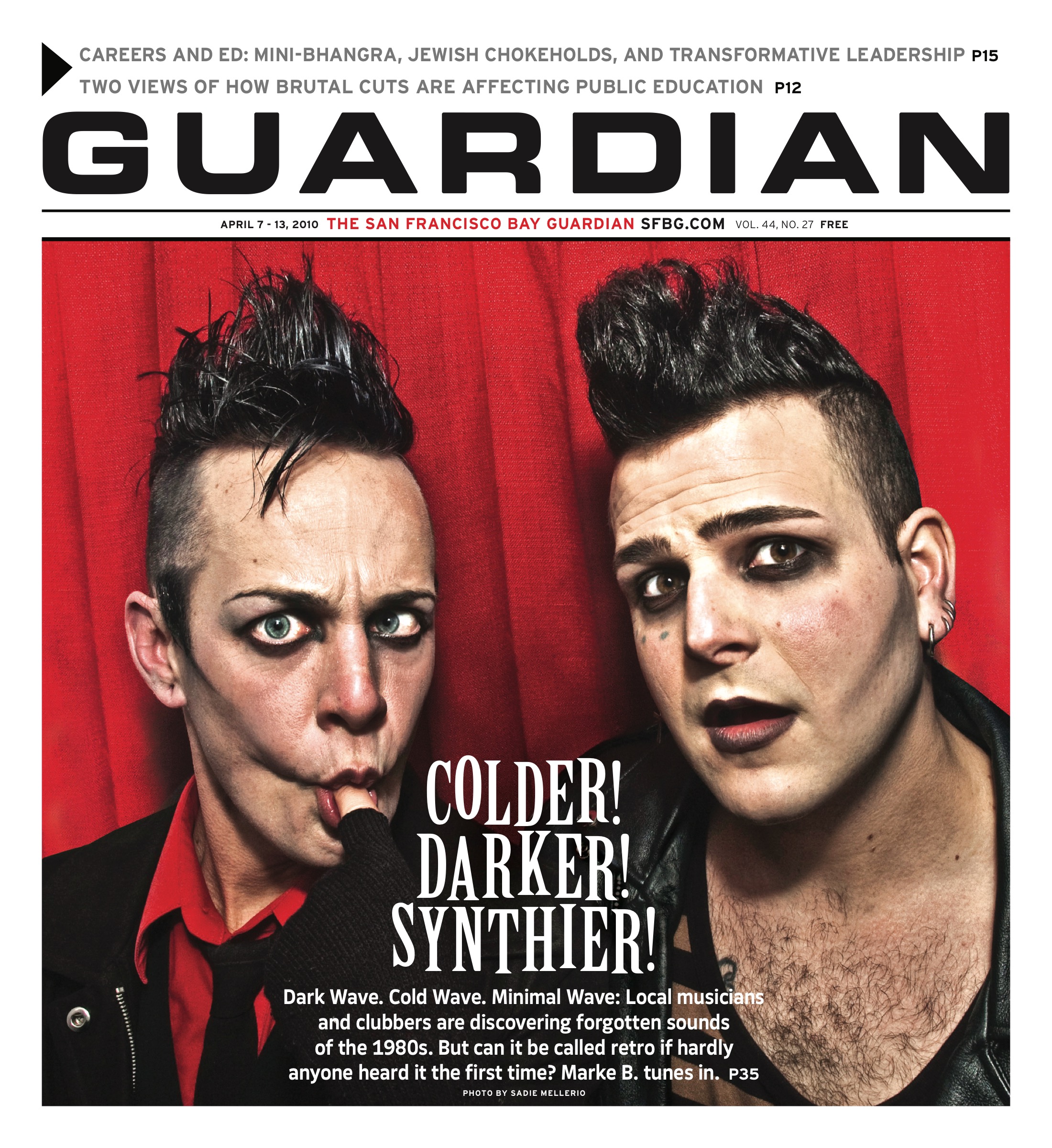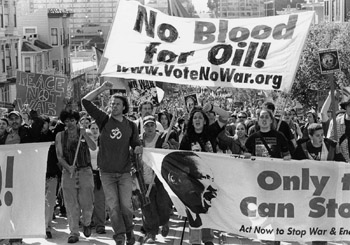Music listings are compiled by Paula Connelly and Cheryl Eddy. Since club life is unpredictable, it’s a good idea to call ahead to confirm bookings and hours. Prices are listed when provided to us. Submit items at listings@sfbg.com. For further information on how to submit items for the listings, see Picks.
WEDNESDAY 17
ROCK/BLUES/HIP-HOP
Astral Force, DC/AC El Rio. 7pm, donation. Benefit for AIDS/LifeCycle.
Epiphanette, Great Girls Blouse, Miriam Speyer and New Blend Retox Lounge. 9pm, free.
Filthy Thieving Bastards, Blag Dahlia, Zander Schloss Thee Parkside. 8pm, $10.
Gomez, Buddy Great American Music Hall. 9pm, $28.
Kegels, Jokes for Feelings, Mitchell Experiment Bottom of the Hill. 9pm, $8.
Kim Wilson Blues Revue Biscuits and Blues. 8 and 10pm, $24.
Camaron Ochs, Spooky Flowers, Ayla Nereo Café du Nord. 9:30pm, $12.
Razorhoof, Iron Witch, Hazzards Cure Hemlock Tavern. 9pm, $6.
Undead Boys, Love Songs, Dope Charge, Keeners Elbo Room. 6pm, $8.
Zoo Station, Stung Slims. 8pm, $15.
DANCE CLUBS
Booty Call Q-Bar, 456 Castro, SF; www.bootycallwednesdays.com. 9pm. Juanita Moore hosts this dance party, featuring DJ Robot Hustle.
Hands Down! Bar on Church. 9pm, free. With DJs Claksaarb, Mykill, and guests spinning indie, electro, house, and bangers.
Jam Wednesday Infusion Lounge. 10pm, free. DJ Slick Dee.
Machine Sloane, 1525 Mission, SF; (415) 621-7007. 10pm, free. Warm beats for happy feet with DJs Sergio, Conor, and André Lucero.
Mary-Go-Round Lookout, 3600 16th St., SF; (415) 431-0306. 10pm, $5. A weekly drag show with hosts Cookie Dough, Pollo Del Mar, and Suppositori Spelling.
RedWine Social Dalva. 9pm-2am, free. DJ TophOne and guests spin outernational funk and get drunk.
Respect Wednesdays End Up. 10pm, $5. Rotating DJs Daddy Rolo, Young Fyah, Irie Dole, I-Vier, Sake One, Serg, and more spinning reggae, dancehall, roots, lovers rock, and mash ups.
Synchronize Il Pirata, 2007 16th St., SF; (415) 626-2626. 10pm, free. Psychedelic dance music with DJs Helios, Gatto Matto, Psy Lotus, Intergalactoid, and guests.
Yoruba Dance Sessions Bacano! Som., 2925 16th St., SF; (415) 558-8521. 9pm, free. With resident DJ Carlos Mena and guests spinning afro-deep-global-soulful-broken-techhouse.
THURSDAY 18
ROCK/BLUES/HIP-HOP
Common Eider King Eider, Raccoons, Das Blut, Hiss and Hum, Marigold Crowns Amnesia. 9pm, $7.
Willie G Biscuits and Blues. 8pm, $15.
Gomez, One Eskimo Great American Music Hall. 9pm, $28.
Groove Armada, Lilofee Fillmore. 8pm, $30.
HIJK, Love is Chemicals, Rademacher Café du Nord. 8pm, $10.
Hurry Up Shotgun, Victory and Associates, Genius and the Thieves Hemlock Tavern. 9pm, $6.
*Jucifer, Grayceon, Serpent Crown Thee Parkside. 9pm, $8.
Static Thought, Spawn Atomic, Step Up! El Rio. 8pm, $7.
Tokyo Raid, Pan Demon, Bitch Be Cool, Housecoat Project, Red Penny One Paradise Lounge. 9pm, $7.
Trifles, Cheetahs on the Moon, Bodice Rippers Hotel Utah. 9pm, $6.
Victims Family, Bar Feeders, Polar Bears Bottom of the Hill. 9pm, $10.
JAZZ/NEW MUSIC
Babatunde Lea Quintet Yoshi’s San Francisco. 8pm, $20.
Dred Scott Quartet Coda. 9pm, $7.
Pepe Jacobo Cigar Bar and Grill, 850 Montgomery, SF; www.cigarbarandgrill.com. 9pm, $7.
FOLK/WORLD/COUNTRY
Bassekou Kouyate, Ngoni Ba Slims. 8pm, $25.
Dime Store Dandy Rite Spot, 2099 Folsom, SF; www.ritespotcafe.net. 9pm, free.
DANCE CLUBS
Afrolicious Elbo Room. 9:30pm, $5-7. DJs Pleasuremaker, Señor Oz, and guest Earthrise Soundsystem spin Afrobeat, Tropicália, electro, samba, and funk.
Club Jammies Edinburgh Castle. 10pm, free. DJs EBERrad and White Mice spinning reggae, punk, dub, and post punk.
DJ Key Bump and Tropicana Madrone Art Bar. 5-9pm. With a performance by Mestiza.
Drop the Pressure Underground SF. 6-10pm, free. Electro, house, and datafunk highlight this weekly happy hour.
Echo-A-Gogo Knockout. 10pm, free. Vintage dub reggae with DJ Lucky and friends.
Electric Feel Lookout, 3600 16th St, SF; (415) 431-0306. 9pm, $2. With DJs subOctave and Blondie K spinning indie music videos.
Funky Rewind Skylark. 9pm, free. DJ Kung Fu Chris, MAKossa, and rotating guest DJs spin heavy funk breaks, early hip-hop, boogie, and classic Jamaican riddims.
Good Foot Yoruba Dance Sessions Bacano! Som., 2925 16th St., SF; (415) 558-8521. 9pm, free. A James Brown tribute with resident DJs Haylow, A-Ron, and Prince Aries spinning R&B, Hip hop, funk, and soul.
Heat Icon Ultra Lounge. 10pm, free. Hip-hop, R&B, reggae, and soul.
Kick It Bar on Church. 9pm. Hip-hop with DJ Jorge Terez.
Koko Puffs Koko Cocktails, 1060 Geary; 885-4788. 10pm, free. Dubby roots reggae and Jamaican funk from rotating DJs.
Meat DNA Lounge. 9:30pm, $2-5. Industrial with DJs BaconMonkey, Netik, Sage, and Unit 77.
Nightvision Harlot, 46 Minna, SF; (415) 777-1077. 9:30pm, $10. DJs Danny Daze, Franky Boissy, and more spinning house, electro, hip hop, funk, and more.
Peaches Skylark, 10pm, free. With an all female DJ line up featuring Deeandroid, Lady Fingaz, That Girl, and Umami spinning hip hop.
Represent Icon Lounge. 10pm, $5. With Resident DJ Ren the Vinyl Archaeologist and guest.
Rock Candy Stud. 9pm-2am, $5. Luscious Lucy Lipps hosts this electro-punk-pop party with music by ReXick.
Solid Club Six. 9pm, $5. With resident DJ Daddy Rolo and rotating DJs Mpenzi, Shortkut, Polo Mo’qz and Fuze spinning roots, reggae, and dancehall.
FRIDAY 19
ROCK/BLUES/HIP-HOP
Joe Bagale, Oona, Thrill of It All Independent. 9pm, $14.
Blasphemous Rumours, Cured Slims. 9pm, $15.
Con Funk Shun Yoshi’s San Francisco. 8 and 10pm, $26-30.
Deceptikon, Captain Ahab, Twin Crystals, Tik/Tak Hemlock Tavern. 9:30pm, $6.
Gomez, Little Ones Great American Music Hall. 9pm, $28.
Groove Armada, Fenech-Soler Live Fillmore. 8pm, $30.
Horse Operas, Goldie Wilson House of Shields. 10pm, $5.
Kaptron, James Lanman, Kit, Kat and the Suitcase Brothers Hotel Utah. 9pm, $10.
Lavay Smith and Her Red Hot Skillet Lickers Biscuits and Blues. 8 and 10pm, $20.
Voodoo Glow Skulls, Hub City Stompers, Compton SF Bottom of the Hill. 10pm, $12.
Yung Mars, Get Back Crew Coda. 10pm, $10.
Z-Trane Electric Trio, Justin Ancheta, Con Brio Pier 23. 9:30pm.
JAZZ/NEW MUSIC
Audium 9 1616 Bush, SF; (415) 771-1616. 8:30pm, $15.
Black Market Jazz Orchestra Top of the Mark. 9pm, $10.
Emily Anne’s Delights Revolution Café, 3248 22nd St, SF; (415) 642-0474. 8:45pm, free.
Equinox Trio Rite Spot, 2099 Folsom, SF; www.ritespotcafe.net. 9pm, free.
Eric Kurtzrock Trio Ana Mandara, Ghirardelli Square, 891 Beach, SF; (415) 771-6800. 8pm, free.
Keith Jarrett Davies Symphony Hall, 201 Van Ness, SF; www.sfjazz.org. 8pm, $30-95.
FOLK/WORLD/COUNTRY
Harlem Gospel Choir Kanbar Hall, 3200 California, SF; www.jccsf.org. 8pm, $40-45.
"Jewish Music Festival" Congregation Sherith Israel, 2266 California, SF; www.jewishmusicfestival.org. 6pm, free. "Journey to Shabbat" performance with Rita Glassman, Yuval Ron, and Jamie Papish. See website for complete festival schedule.
Mazacote Cigar Bar and Grill, 850 Montgomery, SF; www.cigarbarandgrill.com. 9pm, $7.
Nell Robinson, Henriettas Noe Valley Ministry, 1021 Sanchez, SF; www.noevalleymusicseries.com. 8:15pm, $18.
Bassam Saba Arab Cultural and Community Center, Two Plaza, SF; www.arabculturalcenter.org. 8pm, $15.
Smiley Mountain Band Plough and Stars. 9pm, $6-10.
Zoyres Eastern European Wild Ferment Red Poppy Art House. 8pm, $10-15.
DANCE CLUBS
Activate! Lookout, 3600 16th St, SF; (415) 431-0306. 9pm, $3. Face your demigods and demons at this Red Bull-fueled party.
Alcoholocaust Presents Riptide Tavern. 9pm, free. DJ What’s His Fuck spins old-school punk and other gems.
Bridges: Brooklyn to the Bay and Beyond Elbo Room. 9pm, $8. With DJs Concerned and Jimmy Love, and live performance by Andy Allo.
Deep Fried Butter, 354 11th St., SF; (415) 863-5964. DJs jaybee, David Justin, and Dean Manning spinning indie, dance rock, electronica, funk, hip hop, and more.
Dirty Rotten Dance Party Madrone Art Bar. 9pm, $5. With DJs Morale, Kap10 Harris, and Shane King spinning electro, bootybass, crunk, swampy breaks, hyphy, rap, and party classics.
DJ Jeremiah and Friends Madrone Art Bar. 9pm, $5. Afrobeat, ju ju, and tribal funk.
Exhale, Fridays Project One Gallery, 251 Rhode Island; (415) 465-2129. 5pm, $5. Happy hour with art, fine food, and music with Vin Sol, King Most, DJ Centipede, and Shane King.
Fat Stack Fridays Koko Cocktails, 1060 Geary, SF; (415) 885-4788. 10pm, free. With rotating DJs Romanowski, B-Love, Tomas, Toph One, and Vinnie Esparza.
Gay Asian Paradise Club Eight, 1151 Folsom, SF; www.eightsf.com. 9pm, $8. Featuring two dance floors playing dance and hip hop, smoking patio, and 2 for 1 drinks before 10pm.
Good Life Fridays Apartment 24, 440 Broadway, SF; (415) 989-3434. 10pm, $10. With DJ Brian spinning hip hop, mashups, and top 40.
Hot Chocolate Milk. 9pm, $5. With DJs Big Fat Frog, Chardmo, DuseRock, and more spinning old and new school funk. This week’s guest is QDUP Foundation.
Hubba Hubba Revue DNA Lounge. 9pm, $10-15. Burlesque show.
Look Out Weekend Bambuddha Lounge. 4pm, free. Drink specials, food menu and resident DJs White Girl Lust, Swayzee, Philie Ocean, and more.
Loose Stud. 10pm-3am, $5. DJs Domino and Six spin electro and indie, with vintage porn visual projections to get you in the mood.
M4M Fridays Underground SF. 10pm-2am. Joshua J and Frankie Sharp host this man-tastic party.
Oldies Night Knockout. 9pm, $2-4. Doo-wop, soul, and one-hit wonders with DJs Primo, Daniel, and Lost Cat.
Radioactivity 222 Hyde, SF; http://222hyde.com. 6pm, free. Low-budget synthesizers and Eastern European cold war beats.
Rockabilly Fridays Jay N Bee Club, 2736 20th St., SF; (415) 824-4190. 9pm, free. With DJs Rockin’ Raul, Oakie Oran, Sergio Iglesias, and Tanoa "Samoa Boy" spinning 50s and 60s Doo Wop, Rockabilly, Bop, Jive, and more.
Tingel Tangel Club Second Anniversary Blowout Celebration Café du Nord. 9:30pm, $20. With Veronica Klaus, Joey Arias, Basil Twist, Todd Almond, Fauxnique, Marga Gomez, and DJs Juanita More and Bus Station John.
SATURDAY 20
ROCK/BLUES/HIP-HOP
Airfix Kits, Housecoat Project, Teutonics, DJ the Wizard, DJ Phil Lantz Knockout. 5-9pm, free. Crime record signing from 5-6pm.
Tim Barry, Possessed by Paul James, Fire Whiskey Thee Parkside. 8:30pm, $10.
Con Funk Shun Yoshi’s San Francisco. 8 and 10pm, $30.
Shane Dwight Biscuits and Blues. 8 and 10pm, $20.
Foreverland, Barely Manilow Mezzanine. 9pm, $15.
Inferno of Joy, Reaction, Dutch Windmill El Rio. 9pm, $7.
Lilan Kane Blues Band Lou’s Pier 47, 300 Jefferson, SF; www.louspier47.com. 8pm.
Octomutt, Dandeline Rite Spot, 2099 Folsom, SF; www.ritespotcafe.net. 9pm, free.
Rosin Coven, George Cole Quintet, Kim Boekbinder Café du Nord. 9pm, $15.
Ron Silva and the Monarchs, Franco Nero Ska Hemlock Tavern. 9:30pm, $8.
Slipstream Sparrows, Headshear, Richard Bitch, Anhata Sound Hotel Utah. 8pm, $8.
Small Change Romeos, Mavalour, Midway Delta, DJ unk’l funk’l El Rio. 3pm, $8.
Uzi Tattoo, Prik Flower, Economen Thee Parkside. 3pm, free.
Xiu Xiu, tUne-YaRdS, Noveller Bottom of the Hill. 10pm, $12.
JAZZ/NEW MUSIC
Alphabet Soup Coda. 10pm, $10.
Audium 9 1616 Bush, SF; (415) 771-1616. 8:30pm, $15.
Eric Kurtzrock Trio Ana Mandara, Ghirardelli Square, 891 Beach, SF; (415) 771-6800. 8pm, free.
Hiromi, Robert Glasper Experiment Herbst Theatre, 401 Van Ness, SF; www.sfjazz.org. 8pm, $25-55.
Loveseat Trio Revolution Café, 3248 22nd St, SF; (415) 642-0474. 8:45pm, free.
Ricardo Scales Top of the Mark. 9pm, $15.
FOLK/WORLD/COUNTRY
Albino!, Alma Desnuda Independent. 9pm, $17.
Mark Levine and the Latin Tinge Red Poppy Art House. 8pm, $10-15.
Marara Music Store, 66 W. Portal, SF; www.shelbyashpresents.net. 2pm, free.
Pine Box Boys, Earl Brothers, Last Men on Earth, Good Luck Thrift Store Outfit Slims. 8:30pm, $15.
Fito Reinoso Cigar Bar and Grill, 850 Montgomery, SF; www.cigarbarandgrill.com. 9pm, $7.
Sila, Meklit Hadero, DJ Jeremiah Great American Music Hall. 9pm, $14.
Marcus Tardelli, Carlos Oliviera, Ricard Peixoto Brava Theater Center, 2781 24th St, SF; (415) 242-4500. 8pm, $34.
DANCE CLUBS
Bootie: Donner Party DNA Lounge. 9pm, $6-12. Mash-ups with John! John! and the Wagonistas.
Booty Bassment Knockout. 10pm, $5. Hip-hop with DJs Ryan Poulsen and Dimitri Dickinson.
Cockfight Underground SF. 9pm, $7. With DJs Earworm and Matt Hite.
Fire Corner Koko Cocktails, 1060 Geary, SF; 885-4788. 9:30pm, free. Rare and outrageous ska, rocksteady, and reggae vinyl with Revival Sound System and guests.
Fringe: An Indie Rock Dance Party Madrone Art Bar. 9pm, $5. With DJs Blondie K and subOctave.
Full House Gravity, 3505 Scott, SF; (415) 776-1928. 9pm, $10. With DJs Roost Uno and Pony P spinning dirty hip hop.
HYP Club Eight, 1151 Folsom, SF; www.eightsf.com. 10pm, free. Gay and lesbian hip hop party, featuring DJs spinning the newest in the top 40s hip hop and hyphy.
Road to Ultra Supperclub, 657 Harrison, SF; info@santrancecisco.com. 10pm, $15. With Javi Cannus, Sheff, Dutch, Michael Anthony, Jeff Richmond, and Hil Huerta.
Saturday Night Soul Party Elbo Room. 10pm, $10. With DJs Lucky, Phengren Oswald, and Paul Paul.
Sharam 1015 Folsom. 10pm, $10. With DJ Rooz, Taj, and more.
Social Club Lookout, 3600 16th St., SF; (415) 431-0306. 9pm. Shake your money maker with DJs Lee Decker and Luke Fry.
Spirit Fingers Sessions 330 Ritch. 9pm, free. With DJ Morse Code and live guest performances.
SUNDAY 21
ROCK/BLUES/HIP-HOP
B-Stars, Hi Rhythm Hustlers, Royal Deuces, Karling Abbeygate Band Knockout. 9pm, $8.
*Blowfly, Clarence Reid, Knights of the New Crusade, Awesome Party DNA Lounge. 6:30pm, $15.
David Matthew Daniels, Robert Meade, Sean McArdle Brainwash Café, 1122 Folsom, SF; www.brainwash.com. 6pm, free.
Fat Tuesday Band Biscuits and Blues. 8pm, $15.
*Kreator, Kataklysm, Evile, Lightning Swords of Death Slims. 8pm, $24.
Massive Moth, Your Cannons, Here Come the Saviours Hemlock Tavern. 9:30pm, $6.
Janelle Monae Café du Nord. 8pm, $12.
Ralph’s World Swedish American Hall (upstairs from Café du Nord). 3pm, $18.
Rollercoaster, Watch it Sparkle, Sweet Nothing Kimo’s. 9pm.
JAZZ/NEW MUSIC
Terry Disley Washington Square Bar and Grill, 1707 Powell, SF; (415) 433-1188. 6pm, free.
"Jazz Jam Session" Epicenter Café. 6pm, free.
Sunday Sessions Madrone Art Bar. 6pm, free. With Wil Blades.
Kenny Washington Bliss Bar, 4026 24th St, SF; (415) 826-6200. 4:30pm, $10.
FOLK/WORLD/COUNTRY
Motel Drive, Clay Thee Parkside. 4pm, free.
"Salsa Sundays" El Rio. 4pm, $5. With Danilo y Universal.
Jake Shimabukuro Yoshi’s San Francisco. 7 and 9pm, $18-24.
"Te Gusto Musical" Coda. 8pm, $10. With Anthony Blea and friends.
DANCE CLUBS
Call In Sick Skylark. 9pm, free. DJs Animal and I Will spin danceable hip-hop.
DiscoFunk Mashups Cat Club. 10pm, free. House and 70’s music.
Dub Mission Elbo Room. 9pm, $6. Dub, roots, and classic dancehall with DJ Sep, Maneesh the Twister, and guest DJG.
Gloss Sundays Trigger, 2344 Market, SF; (415) 551-CLUB. 7pm. With DJ Hawthorne spinning house, funk, soul, retro, and disco.
Honey Soundsystem Paradise Lounge. 8pm-2am. "Dance floor for dancers – sound system for lovers." Got that?
Kick It Bar on Church. 9pm. Hip-hop with DJ Zax.
Stag AsiaSF. 6pm, $5. Gay bachelor parties are the target demo of this weekly erotic tea dance.
MONDAY 22
ROCK/BLUES/HIP-HOP
American Studies, Ash Reiter, Mark Matos and Os Beaches Elbo Room. 9pm, $6.
*Karine Denike, Dina Maccabee Band, Upstairs Downstairs Knockout. 9pm, $7.
"Felonious Presents Live City Revue" Coda. 9pm, $7.
Mama Lion, Eighteen Individual Eyes, Heated El Rio. 7pm, $5.
Janelle Monae Café du Nord. 8pm, $12.
DANCE CLUBS
Bacano! Som., 2925 16th St., SF; (415) 558-8521. 9pm, free. With resident DJs El Kool Kyle and Santero spinning Latin music.
Black Gold Koko Cocktails, 1060 Geary, SF; 885-4788. 10pm-2am, free. Senator Soul spins Detroit soul, Motown, New Orleans R&B, and more.
Death Guild DNA Lounge. 9:30pm, $3-5. Gothic and industrial with DJs Decay, Joe Radio, and Melting Girl.
Manic Mondays Bar on Church. 9pm. Drink 80-cent cosmos with Djs Mark Andrus and Dangerous Dan.
Motown on Mondays Madrone Art Bar. 6pm, free. With DJ Gordo Cabeza and guests.
Monster Show Underground SF. 10pm, $5. Cookie Dough and DJ MC2 make Mondays worth dancing about, with a killer drag show at 11pm.
Network Mondays Azul Lounge, One Tillman Pl, SF; www.inhousetalent.com. 9pm, $5. Hip-hop, R&B, and spoken word open mic, plus featured performers.
TUESDAY 23
ROCK/BLUES/HIP-HOP
Axe, Terroritmo, Foga Na Roupa Elbo Room. 9pm, $7.
Devendra Banhart and the Grogs, Dorothy and the Originals Warfield. 8pm, $27.50-32.50.
Bias Tape, AJ Rivlin El Rio. 8pm, free.
Jason Collett, Bahamas, Zeus Café du Nord. 8:30pm, $15.
Jamie Cullum, Imelda May Fillmore. 8pm, $35.
Fell Voices, Addaura, Elk, Necrite, DJ Rob Metal Thee Parkside. 8pm, $8.
Ted Leo and the Pharmacists, Bleached Great American Music Hall. 9pm, $17.
Serena Maneesh, Depreciation Guild, Veil Veil Vanish Bottom of the Hill. 9pm, $12.
Savoy Brown Biscuits and Blues. 8pm, $20.
Stagger and Fall, Hollowbodys, Idle Threats, Hounds and Harlots Knockout. 9:30pm, free.
Thralls, All Time High, Hollow Earth Hemlock Tavern. 9pm, $6.
DANCE CLUBS
Alcoholocaust Presents Argus Lounge. 9pm, free. With DJs Corruptor Ref, Sebastian Twot, and What’s His Fuck.
Eclectic Company Skylark, 9pm, free. DJs Tones and Jaybee spin old school hip hop, bass, dub, glitch, and electro.
La Escuelita Pisco Lounge, 1817 Market, SF; (415) 874-9951. 7pm, free. DJ Juan Data spinning gay-friendly, Latino sing-alongs but no salsa or reggaeton.
Share the Love Trigger, 2344 Market, SF; (415) 551-CLUB. 5pm, free. With DJ Pam Hubbuck spinning house.
Womanizer Bar on Church. 9pm. With DJ Nuxx.


